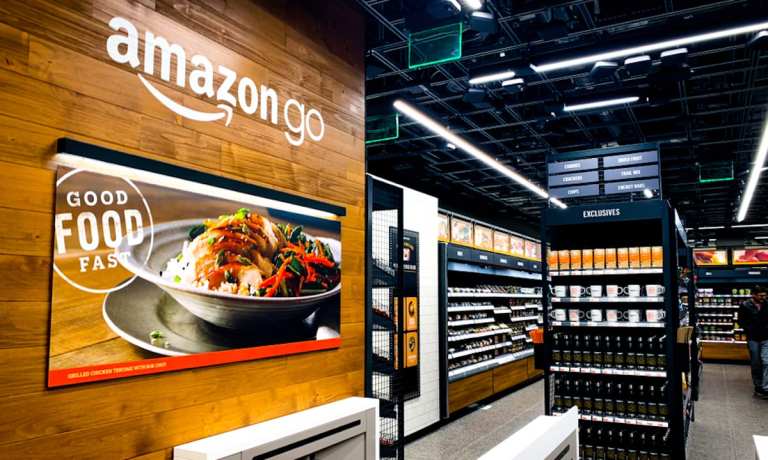Amazon Go To Launch In UK Amid Lackluster Physical Store Sales

Amazon will soon open its first Amazon Go store in Ealing, West London, according to the Daily Mail. The news comes months after the retail giant first applied for a signage permit in November, reports Pocket-lint, in advance of 30+ more Amazon Go U.K. stores, according to Forbes.
Amazon Go, the chain’s grab-and-go meal and snack shop, and Amazon Go Grocery, the fresh produce and bakery version of the chain, use the retailer’s “Just Walk Out” technology for line-free, cashierless checkout, allowing consumers to walk out of the store and have their merchandise auto-charged to their Amazon account or credit card.
“This has pretty broad applicability across store sizes, across industries, because it fundamentally tackles a problem of how do you get convenience in physical locations, especially when people are hard-pressed for time,” Dilip Kumar, vice president of physical retail and technology at Amazon, told Reuters last year.
The London launch comes on the heels of mass consumer interest in the U.S. A recent Piplsay poll found that 57 percent of Americans would be excited to see Amazon Go or stores with similar technology open in their area, though only 28 percent of consumers have actually been to one of these stores. Additionally, six in 10 respondents said that Amazon Go posed a significant threat to the more traditional, brick-and-mortar-native grocery giants.
As Amazon Go expands internationally, Amazon Fresh is expanding its physical presence domestically. Last Thursday (Feb. 25), the chain opened its tenth store, a 45,000-square-foot location in Fullerton, California, reports Chain Store Age. The stores are built with Alexa-enabled artificial intelligence (AI) customer service kiosks, and they double as sites for Amazon package pickups and returns. There are currently seven locations in California and three locations in Illinois.
These grocery store expansions come after the company’s CFO Brian Olsavsky told analysts that Jeff Bezos would be stepping back from his role as CEO to focus on more specific matters, including the company’s grocery presence, reported Winsight Grocery Business. Olsavsky said that Bezos would be “involved in many large one-way-door issues … meaning the more important decisions. Things like acquisitions. Things like strategies and going into grocery.”
Amazon’s brick-and-mortar grocery presence has included Whole Foods since it acquired the health-food-centric grocery store in 2017. Discussing the acquisition three years later, Whole Foods CEO John Mackey said, “They’re making investments in technology for Whole Foods that I think will be transformative. And they’ve been respectful of our culture; they haven’t tried to just turn us into Amazon. So, the best way to answer that question is, ‘John, if you could do it all over again, would you make the same decision?’ And the answer is yes. It was the right decision for us.” In an interview with Winsight, he even referred to the relationship with Amazon, as the retailer began expanding the Amazon Fresh line, as a “happy marriage.”
Despite this rapid expansion, Amazon’s brick-and-mortar presence is far from its fastest-growing channel, at least as far as sales are concerned. PYMNTS’ January edition of the Whole Paycheck Tracker found that revenues at its physical stores — Amazon Books, Amazon Go, Amazon Fresh and Whole Foods — were essentially flat, at about $3.8 billion for both Q2 and Q3. Additionally, the report found that Amazon continues to have a very small share of the food and beverage market. The company saw a minimal gain in grocery from Q2 to Q3, from $5.6 billion to $5.8 billion (counting both online and offline sales), reported the study.
Furthermore, its share of consumer spend stayed flat at 1.8 percent. The grocery industry is populated with aggressive, well-run companies like Kroger and Ahold Delhaize, which have stepped up their digital capacities and added to their loyalty programs. In Q4, the company’s physical stores, which include all of its grocery chains, fell 8 percent, per the earnings release. It remains to be seen whether the chains’ expansions at home and abroad will turn this trend around or lead to further losses.
Read More On Amazon Go:
- Sam’s Club Scans the Future With AI-Powered Checkout Technology
- Amazon Uses Priceline Partnership to Grab Travel Spend on Prime Day
- Amazon Uses Prime Day Deals to Drive Traffic to Physical Stores
- Amazon Rethinks Footprint for Cashierless Amazon Go Stores